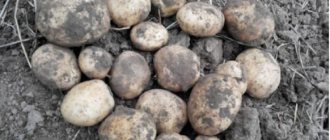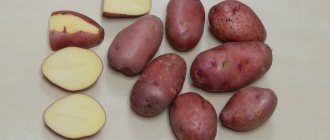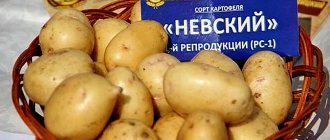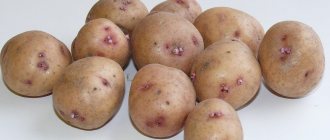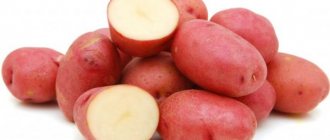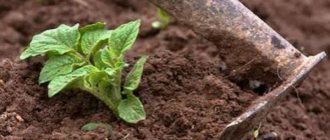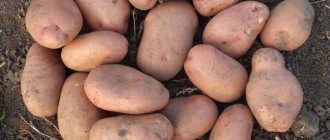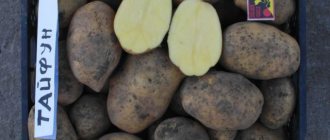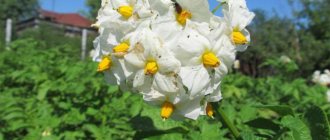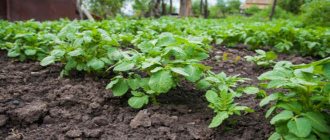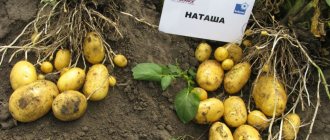Potatoes have long become the second bread for residents of different parts of the world, including the CIS countries. However, harsh climatic conditions are not always suitable for growing even such an unpretentious vegetable. Veneta potatoes (also called Vineta) ripen well in poor soils and during dry periods. But even with such a “patient” variety you need to know how to handle it.
History of the variety
Veneta is a potato variety selectively bred in Morocco by German agronomists in the mid-20th century. The goal of breeders is to obtain a vegetable that is resistant to drought and disease and produces an early harvest. For the most part, the idea was a success. The originator of this potato variety is EUROPLANT PFLANZENZUCHT GMBH.
The Veneta variety is easy to process and produces high root crop yields. It began to be grown in the CIS countries only in the 2000s. But the demand for it immediately became great.
Main characteristics
Vineta potatoes have been included in the state register of the Russian Federation since 2001, recommended for cultivation in the Central, North Caucasus, Ural, Volga-Vyatka, Middle Volga, as well as in the southern regions. If the requirements for growing conditions are met, about 240-300 centners per hectare are harvested per season (240-300 kg per one hundred square meters). In warm regions, this variety is used for replanting, producing two harvests per season.
On a note! Among gardeners, the common name of the variety is Veneta. Although the variety is correctly called Vineta, the variety is registered in the State Register as Vineta.
The variety is certified as a table variety. The studies carried out confirmed compliance with Russian and international standards. Veneta is not only tasty, but also an environmentally friendly variety.
The German variety Vineta is the fruit of the work of Klaus Günther, producer of Europlant from eastern Germany. This tasty, productive variety has a slightly rough skin. Because of this feature, the variety was doomed to failure in Germany. In the German market, potatoes that do not have smooth, easy-to-peel skins have no chance of success. The variety has gained popularity in our fields and gardens.
The main indicators and characteristics of the Vineta variety are given in the table.
| Index | Description |
| basic information | A German early-ripening table variety of medium yield, not overcooked, cultivated in arid regions, and not susceptible to the harmful effects of a number of common potato viruses and fungi. |
| Starchiness | Tubers contain an average amount of starch compared to other types, no more than 15%. |
| Growing season | No more than 75 days. |
| Description of tubers | Vineta potatoes are small in size; tubers weighing no more than 95 g are characterized by a round shape, have a dense yellow skin and light yellow flesh. |
| Taste qualities | After cooking, the pulp does not change color, remains firm, has a rich potato taste, recommended for use in salads, stews, first courses, and suitable for frying. |
| Safety | In a dry room with good ventilation during the autumn-winter period, about 85-88% of the crop is preserved. |
| Description of the bush | Medium-sized bushes grow compactly, reach 70 cm in height, bloom with snow-white corollas, and during ripening, 10-12 tubers are collected from each bush. |
| Features of cultivation | Vineta potatoes are best grown in light to medium soils. This variety has average water requirements and is drought resistant. It is recommended to plant germinated seed in dug up soil; when applying fertilizing, it is advisable not to overuse large amounts of nitrogen fertilizers to increase taste characteristics and shelf life. |
Important! The Vineta variety is suitable for cultivation in regions with unfavorable weather conditions (insufficient rainfall, late spring and short summer). It is not advisable to grow in places with high humidity and frequent heavy rains.
Description of Veneta potato variety
The Veneta variety is a unique very early table potato. It tolerates transportation well, evenly surviving both drought and temperatures down to zero degrees Celsius. Therefore, it is recommended to plant it in regions with difficult climatic conditions.
The variety underwent laboratory tests that confirmed its suitability for food, energy value and high taste characteristics.
Escapes
Veneta bushes are large in size. Their height is 50-70 cm. The leaves are wide, bright, light green in color, grow densely along the entire stem, the edge of the leaf has a faint wavy line. Flowering is represented by 3-7 large white flowers with a yellow core.
Roots
The potatoes themselves are relatively small, oval and oval-round in shape. The color of the skin of a mature tuber varies from dirty yellow to light brown, with a slight “network”. The pulp is light, yellow, the weight of the tuber varies from 60 to 100 grams.
It is not characterized by such defects as cracks, dark gray and green spots. The eyes are small, almost invisible, and do not grow deep into the tuber, which helps the potato remain edible longer. Starchy index: 13-15%.
Characteristics of Veneta potatoes
These are dessert potatoes - the result of the work of German breeders. It is well suited for farmers growing crops in regions with difficult climatic conditions. The drought resistance of the early ripening variety made it possible to plant it in Central Asia. The moisture-resistant quality of the fruit is suitable for the southern region. Fast ripening times are appropriate for the short Ural summer. Long shelf life makes it possible to grow the crop on a production scale.
Productivity
The priority characteristic of the Veneta potato variety for vegetable growers is not only the unpretentiousness of the crop in care, but also the simultaneous formation of 10 or more tubers in a bush. Harvesting in the southern regions is possible in two stages. The first harvest takes place in July, landing in mid-March. From 1 sq. m with proper cultivation of the soil, the harvest reaches 2.5 kg, about 60 days pass from the moment of planting. If a root crop is taken that has not reached full maturity (45 days after planting), the yield is 1.3 kg.
After harvesting, the plot is replanted with the “Veneta” variety. The next collection occurs at the end of September and amounts to 1 sq. m up to 2.2 kg. In temperate climates, the yield is the same; the plot is planted only once.
Attention! 2 weeks before harvesting, the tops of the bush begin to wither; it is recommended to cut them off. This measure is necessary for the rapid formation of the tuber peel.
Resistance to diseases and pests
An important advantage of the variety, judging by the reviews, is that the “Veneta” potato is practically immune to fungal and bacterial infections:
- rotting of root crops;
- golden nematode;
- wrinkled mosaic;
- potato cancer.
The only disease that affects Veneta is late blight. It occurs infrequently and spreads only to the tops, without affecting the tubers. As with any potato variety, Veneta is parasitized by Colorado potato beetle larvae. There are sufficient remedies for this problem on the agrochemical market, so pest control is not essential.
Advice! To rid potatoes of late blight, before planting in the ground, you need to dip the seeds for 10 minutes in a solution prepared from copper sulfate, manganese, boric acid, 1 tbsp each. l per 10 liters of water.
Advantages and disadvantages of the variety
According to the characteristics and reviews of vegetable growers, the variety has no disadvantages. The following factors make Veneta potatoes attractive for cultivation both on private plots and on large farm areas:
- Early ripening time - 2.5 months from planting.
- The vegetable does not lose its taste when harvesting a young crop early (after 1.5 months).
- The culture is undemanding in care.
- High potato yield - up to 2.5 kg per 1 sq. m.
- Feels comfortable on any soil.
- Weather resistance - easily tolerates drought.
- Good taste.
- Maintains its shape during cooking.
- Long shelf life, virtually no waste.
- Resistant to mechanical damage, easily transported over long distances.
- Not susceptible to traditional cultural diseases.
- Does not require watering from the beginning of planting until harvest.
Characteristics of the variety
The Veneta variety has a number of properties that have made it one of the most popular, especially in the northern districts of Russia and the arid regions of Central Asia. These include:
- Rapid ripening of the crop . The growing season lasts about 70 days, and after 40-45, young tubers can be dug up.
- Drought resistance . Veneta can go without watering for a long period.
- Keeping quality . It is determined by the indicator 87%, potatoes easily survive long-term storage.
- Appearance. Neat tubers, without physical defects and eyes, are well purchased by consumers.
- Transportability . Tubers tolerate transportation well over long distances. They are hard and elastic enough so that they are not afraid of mechanical shocks and falls.
But the most important indicator of the quality of the Veneta variety is its disease resistance. Having planted potatoes, you don’t have to worry about:
- leaf roll virus;
- mosaics and spotting;
- scab;
- black leg;
- potato cancer;
- potato nematode;
- tuber rotting;
- viruses A and Y.
Despite its resistance to most diseases, the Veneta variety is susceptible to late blight.
Advice from experienced gardeners and reviews about the Vineta variety
Farmers highly appreciate the variety, as evidenced by numerous laudatory reviews on specialized forums.
Tamara, Krasnodar: “I’ve been growing this variety for six or seven years now, I’m completely satisfied with it - the harvest is plentiful, the potatoes are tasty, they don’t get too overcooked. But I want to warn you that the plot must be quite large to grow this variety. The fact is that you can dig it up in 1.5 months and change the planting site for 3 years. Therefore, if there is little space, then it is better to choose another variety.”
Pavel, Kaluga: “I tried to grow different varieties, and all of them had a problem with leaves curling. I read the description of the Vineta potato variety, looked at the photo, heard about its resistance to disease and decided to try it. I didn’t regret it - not a single bush got sick, it bloomed well, and the harvest was simply gorgeous.”
Vasily, Novgorod region: “I live in a village, I plant potatoes every year. Of all the varieties I tried to grow, I settled on Vineta. So far it seems to me that I have found my ideal. Vineta does not get sick, produces an excellent harvest and does not require any too complicated care.”
Productivity and taste
Potatoes are characterized by high yield. From one bush you can collect up to 3 kg (12-17 tubers). On average, 160-230 centners of vegetables are harvested from 1 hectare.
A high level of tuber survival and a rich harvest are combined in this variety with good taste. When cooked, the potatoes do not become soft and do not acquire a gray-white color. It quickly becomes covered with a delicious golden crust when deep-fried or in a frying pan. With Veneta, any culinary experiments are possible. It makes both purees and chips equally well. Veneta potatoes retain a pleasant yellow color after heat treatment.
Description of the variety, appearance
Veneta is an early-ripening variety, the tubers of which reach technical maturity by the 65th day, but early potatoes can be dug already on the 50th day after planting.
It is recommended to store these potatoes from the 75th day after the emergence of friendly shoots. The size of the root crops of the Veneta variety is average, usually the weight reaches 90-110 g. In this case, from 10 to 12 tubers are formed under the bush. There are very few small waste potatoes under the bushes; basically, the entire ovary reaches a marketable appearance and size. The skin of the Veneta potato is thin, ranging from brown to light sandy depending on the type of soil in which the crop was harvested. The peel can be covered with a pattern in the form of a thin mesh: this pattern is a variant of the norm and appears in cases where the potatoes were grown in unfavorable conditions with a small amount of moisture.
The Veneta potato plant is distinguished by a tall bush up to 75 cm. It has dark green leaves, thick tops, and is not prone to lodging. Veneta blooms with small white flowers collected in a dense inflorescence.
The color of the pulp of potatoes of this variety is white, beige, yellowish. The taste is very high. Due to the low starch content (about 13-14%), potatoes retain their whole appearance when boiled, which is highly valued when boiling jacket potatoes and for salads. The Veneta variety is perfect for producing crispy fried potatoes, as it will not boil and turn into puree during the cooking process.
We recommend! Prepare a classic German salad with Veneta: peel boiled warm potatoes, add the juice of half a lemon, a little salt and ground black pepper to taste! Season with vegetable oil. This variety seems to be made for German salad!
Advantages and disadvantages of the variety
The Veneta variety has the following strengths:
- high level of immunity;
- unpretentiousness to climatic conditions and soil nutrition;
- large volumes of harvest;
- short ripening period;
- neat appearance of tubers;
- ease of storage and transportation;
- good taste;
- maintaining shape and color during cooking.
The disadvantages experienced gardeners include is that the Veneta variety grows slowly on soil that was previously treated with nitrogen fertilizers; it should also be protected from late blight of tops and tubers, insect pests; potatoes can deteriorate if the weather was rainy and the ground became swampy.
Productivity
The Veneta variety produces stable good yields even under unfavorable dry conditions, as well as in sandy and clay soils. On average, under a bush there are 10-12 tubers weighing up to 100 g; under good conditions, the number of tubers increases to 15-16. All tubers have an even, smooth appearance, oval, with a light-colored skin. On average, the yield is up to 400 centners per hectare. The possibility of obtaining two harvests during the growing season can increase this figure by 1.5 times.
Features of planting and growing
Even with such an unpretentious variety as Veneta, the characteristics of the vegetable should be taken into account so that the harvest is as large as possible and the efforts are not wasted.
Preparing the site for planting
Sprouted tubers should be planted in late April - early May. Before this, in the fall, it is advisable to fertilize the soil with humus and dig it up.
This variety should not be planted where nightshade crops grew. The soil after them will become suitable for Veneta after 3 years. But the soil will be favorable after legumes, grains, and herbs.
It is better not to use alumina for planting Veneta, because it retains water for a long time. The Veneta variety does not like wet soil . For the same reason, lowlands are not suitable either. But it forms tubers well and grows in:
- alumina;
- sandstone;
- sandy loam soil;
- loamy soil;
- mineral soil;
- cultivated peatlands.
A flat, unshaded area on a hill would be ideal.
Tuber preparation
You need to select material 3-4 weeks before planting. The tubers should be approximately the same size, but no less than 40 grams and no more than 85 grams. Potatoes that already have sprouted eyes 1-2 centimeters high will sprout best. It is important that there is no mold or rot on the root vegetables.
A tuber that is too large will become suitable for germination if you cut it in half and dry the cut with wood ash.
You can strengthen Veneta potatoes selected for planting by treating the tubers with solutions:
- boric acid;
- vitriol;
- wood ash;
- manganese
Then place the potatoes in a light, dry place to release the alkaloid solanine. It is a natural immunomodulator of the vegetable.
If there is a need to accelerate the growth of already early ripening potatoes, then it is permissible to use Poteytin, Epin and Planriz. The preparations should be applied to the tubers one day before planting in the soil.
Planting in the ground, planting scheme
It is recommended to plant potatoes in dry and clear weather; it is important that there are no night frosts. The area prepared for planting Veneta potatoes must be divided into rows. The distance between them should be 50-70 cm, and between planting tubers - 25-35 centimeters.
The required depth of the holes is 7-10 centimeters. The sprouted tuber must be placed inside carefully, with the sprouts facing up. When falling asleep, try not to damage them. Shoots will appear in 10-14 days.
Fertilizer application
Mineral fertilizers are applied twice during irrigation during the entire period of tuber formation. The first time is before the potatoes bloom, the second time is after it.
Before the formation of buds, to improve the quality of potatoes, fertilize with potassium fertilizers. After flowering, superphosphate is added to the soil (30 g diluted in 10 liters of water). The dosage indicated is for one potato plant. This fertilizing promotes better formation of tubers.
Between these two procedures, you need to have time to add a solution of bird droppings and cow manure. Such organic fertilizer will increase the yield of the vegetable and its resistance to pests.
Care
Veneta potatoes are watered three times:
- immediately after disembarkation;
- during the appearance of buds;
- after flowering.
It should be plentiful, about 50 liters per square meter. Watering time is important. It should be either early morning or late evening. You need to pour water at the root, since drops on the leaves can cause sunburn (a lens effect occurs). If the weather was rainy, then one of the waterings should be abandoned. To determine the need for moisture, you need to look at the condition of the soil, the main thing is not to make it swampy.
In the arid southern regions, on the contrary, the amount of watering can be increased.
Potatoes need water if the soil has dried out deeper than 8 cm.
To remove weeds, it is necessary to weed the Veneta variety regularly, starting from the first week after planting.
Tubers especially need oxygen, so loosening is carried out at least once every 2 weeks. The first should be done before seedlings emerge.
Hilling should be done at least twice. The first time after germination, the second time when the sprouts are about 15 centimeters in height.
Growing Tips
Vineta is considered an unpretentious variety. The process of growing these potatoes is quite simple:
- It is necessary to sort and select tubers weighing 50–70 g.
- Germinate them in the light at a temperature of +12…+15 °C for a month. During the germination process, you can treat them with growth stimulants, for example, Planriz.
- Before planting, disinfect the tubers with copper sulfate, potassium permanganate or a solution of wood ash.
- Choose well-drained areas for planting. Plant in rows at a depth of about 10 cm with a distance between plants of 60 cm and between rows of 40 cm.
- Weed as weeds appear.
- Hill up about a month after planting.
Grown potatoes need to be hilled to improve the process of tuber formation
- Watering and fertilizing are carried out depending on the external growth conditions and the saturation of the soil with nutrients.
- Harvest after complete lodging of the tops.
Video: the intricacies of growing potatoes
Protection from diseases and pests
To protect against insects, you can put onion peels or wood ash at the bottom of the hole dug during planting. To prevent the Colorado potato beetle from invading the edges of the potato plot, it is worth planting:
- legumes;
- geranium;
- marigold;
- garlic;
- mint;
- parsley
Chemical protectants against beetle pests include insecticides. But it is safer for the crop to mechanically combat the Colorado vegetable garden invader. It is also possible to use folk remedies. For example, spray the bushes with an infusion of wormwood and wood ash.
To protect against fungus, Veneta potatoes should be treated with fungicides. They are also effective in the fight against late blight.
Harvesting, storage
It is advisable to harvest Vineta at an air temperature of about 12 °C, since it provides adequate protection of the tubers from damage. The average yield is 40 t/ha (400 kg per hectare).
Mature tubers are dug up, dried, sorted and prepared for storage. To do this, they are laid out in bags or boxes and placed in the cellar. During the summer, the storage room is cleaned of last year's harvest and treated with lime or copper sulfate solution for disinfection.
Veneta potatoes are a popular early variety with good keeping quality. Suitable for harvesting for the winter (for this, the second harvest of the season is usually used). Recommended for frying, preparing first courses and salads.
Harvest and storage
The first young potatoes can be harvested 45 days after emergence. The skin will become rough around the 75th day. A clear sign of readiness for harvesting of the Veneta variety will be yellowing of the tops.
After digging, the potatoes need to be sorted. Set aside mechanically damaged tubers; they will be eaten immediately. Dry the rest of the potatoes, remove any clods of earth and put them in bags, boxes or nets. A dry, dark, cool room is suitable for storing potatoes, but the temperature in it should not fall below +15 degrees, it is advisable that it be ventilated at least sometimes.
The Veneta potato variety has all the necessary characteristics both for large-scale cultivation and for planting in a small garden. It has high immunity, produces rich harvests, and the tubers are unpretentious to storage conditions. The variety is valued for its taste and is suitable for any method of heat treatment.
0
0
Copy link
Potato care
Since diseases do not interfere with the growth of the root crop, caring for the Veneta variety is easy. Let's look at the features of agricultural technology.
What soil are potatoes planted on?
Before you start spring work, you need to decide on a site for planting potatoes. In general, the Veneta variety is unpretentious. But still, a few words need to be said about the soil.
Warning! It is undesirable to use soils containing clay for planting potatoes. Water stagnates on them.
If legumes grew on the site last year, then this is the best place. Potatoes do not like waterlogging, so there is no need to water them during the growing season. It grows well even in dry summers.
Planting potatoes
Since Veneta potatoes are early ripening, they are planted to obtain an early harvest. As a rule, in early May (based on the readiness of the land).
A week or two before planting, the tubers are pulled out of storage so that the potatoes warm up and sprout. When planting, there is no need to deepen it, 7-10 cm is enough.
After the emergence of seedlings, the first loosening is carried out to destroy small weeds and enrich the root system with oxygen. If the weeds reappear before hilling, you need to go through the hoe again.
It is advisable to hill up twice. In this case, moisture is retained, a high ridge above the bush is the key to the formation of a large number of stolons, which means the harvest will be excellent. Sometimes on a summer cottage they use walk-behind tractors for hilling the Vineta variety. Look at the photo: even rows.
It is not necessary to water, but if it doesn’t rain, you can lightly shed it only between the rows.
How to store
It is best to store Veneta potatoes in nets or bags. The room must be dry and ventilated from time to time. A little humidity is allowed. At elevated temperatures, the tubers dry out, wrinkle, and begin to germinate ahead of time.
Rules for storing potatoes on video:
Features of cultivation
Vineta is a very unpretentious crop. Probably due to this property, a huge number of gardeners cultivate it in our country. Even an inexperienced person can grow these potatoes. It is enough to follow a few recommendations and you can grow a wonderful, tasty harvest.
Soil preparation
The best areas for the germination of this potato are areas with light loamy or sandy loam soil, which dries out and warms up faster in the spring. Thanks to this, potatoes can be planted earlier. The best predecessors for potatoes are considered to be crops such as cucumbers, cabbage and legumes.
They prepare the soil in the fall. The finished soil should be loose, airy, well-drained, and ready to receive seedlings. For early potatoes, deep digging and application of fertilizers are necessary. For 100 square meters of land you need approximately 50 buckets of compost. To get a lot of tasty and high-quality tubers, you need to add rotted manure or peat manure compost. But fresh organic matter adversely affects the taste of potatoes, so it is better to avoid them. If you apply pure peat in the form of fertilizer, this will not affect the yield. It is better to use it as part of compost: mix peat with manure in equal quantities. If there is no peat, post-harvest plant materials (leaves, sawdust) will do. After mixing the ingredients, the mixture should sit for several months.
Superphosphate is added from mineral fertilizers, and potassium magnesium is added from potassium fertilizers.
In the spring, before planting, the soil must be dug up again to a depth of 20 centimeters. Nitrogen fertilizers are applied.
Tuber preparation
Seed potatoes are prepared for planting in advance, in early spring. First, only high-quality, large fruits, approximately 50 grams in weight, are selected. Cutting seed potatoes is only possible for large fruits. Many gardeners germinate potatoes first. To do this, lay the seeds out in the light, then put them in a humid environment so that sprouts can sprout. The temperature in the room should not rise above 10 degrees, otherwise the potatoes will dry out and lose their life-giving powers.
Tip: if you have little space, you can germinate tubers in plastic bags. To ensure that the tubers are ventilated and do not rot, holes are made in the bags.
You don’t have to germinate the tubers in advance. This is what most gardeners do. However, in order to stimulate the growth of potatoes, they need to be kept in warm temperature conditions for at least ten days. This way the tubers will warm up and their eyes will open.
Planting potatoes
Potatoes are planted at the very end of the second spring month or the beginning of May, when the soil warms up to a temperature of 8 degrees. Since Vineta ripens quite early, in the south it is planted even earlier. A separate hole is dug for each potato and flavored with ash. The ash contains many microelements that improve the growth and development of plants. A couple of hours before planting, planting material can be dipped in a solution of mineral fertilizers. The distance from one hole to another should be 40-45 centimeters, between rows - 75 centimeters.
Tubers are planted to a depth of 8-10 centimeters and covered with soil. The first shoots appear 10 days after planting. It is recommended to completely cover the young sprouts with soil so that they do not accidentally freeze. From the moment the stems are back on the surface, the period of caring for the future harvest begins.
You may be interested in: Dates for planting potatoes in May-June 2021 according to the lunar planting calendar Favorable days for planting potatoes in 2021 according to the lunar calendar Dates for planting potatoes in 2021 for central Russia and the Moscow region
Tip: It is not recommended to plant potatoes in the same place for several years in a row. Over time, the soil becomes depleted and yields decline.
Care
Vineta is a very unpretentious potato variety. Coupled with the fact that it has strong immunity to all kinds of diseases, growing it is very simple and pleasant. Like all other crops, Vineta loves the gardener to follow a number of simple rules for its care. For this, she gifts a person with an abundant, high-quality harvest.
Basic rules of care:
- Watering. This variety tolerates drought well, so there is no need to specifically water the potatoes, especially during the period of stem growth. Natural precipitation is enough for him. But during flowering and intensive fruit growth, plants need more moisture, so it won’t be superfluous to water them.
- Hilling. This technique allows the soil to be saturated with oxygen and nourish the rhizomes. Hilling stimulates the formation of new stolons, which increases yield. In addition, hilling prevents freezing of immature seedlings in the first month, when frosts sometimes occur at night. Over the entire season, you need to do this procedure an average of three times. Before the expected frosts, it is better to completely cover young plants with soil.
- Feeding. To stimulate plant growth and root development, fertilizing is applied. Fertilizers are applied for the first time during the ripening period of the tops. As experienced agronomists think, summer fertilizing is not effective if the soil is well fertilized before planting. This only leads to the growth of tops to the detriment of tuber formation and the formation of more starch. Fertilizing is useful only when the plant is not growing well or if it was not possible to apply fertilizer in the spring. Fertilizing should be carried out during budding or the beginning of flowering, but not later. Important : it is better to feed plants with liquid fertilizers after watering, since applying fertilizers “dry” can burn the roots of the plant.
- Prevention of diseases. Vineta is resistant to diseases, but for prevention it is worth spraying the potato bushes with Hom (40 grams per 10 liters of water) 2-3 times per season. Treating bushes with Actellik and Decis will help in the fight against such a malicious pest as the Colorado potato beetle. Wireworms are usually caught using potato baits. And for mole crickets, use corn or wheat traps.
Selection
Selection work was carried out in many countries around the world and continues today. The main task of scientists is to create a universal variety that meets the requirements of any consumer.
At the end of the 20th century, breeders from Germany made a gift to potato lovers. They developed the Veneta variety (in some sources it is called Vineta).
Scientists have managed to achieve stable potato qualities that are repeated in subsequent generations. The main advantage of a varietal vegetable is its ability to resist diseases and pests.
Russian gardeners were delighted with the early harvest of Veneta potatoes. The first tubers were imported in 2002. Potatoes first firmly established themselves in household plots in the central and southern regions of the country. Today, its cultivation has expanded its horizons; those who like to experiment are planting the Veneta potato variety in many areas.
Farmers are engaged in growing the branded variety of German potato breeders. A tasty vegetable produces good yields with minimal labor. The Russians have understood the taste characteristics of potatoes and are buying them up quickly.
fermilon.ru
Characteristics and description
general characteristics
Potatoes belong to the table mid-season varieties of domestic selection. The selection time from planting to harvesting depends on weather conditions and ranges from 80 to 95 days.
Description of appearance and photo
- Escape. Potato bushes are dense, low, spreading with white flowers. Medium sized green leaf.
- Roots. The tubers are oval-shaped, large with small eyes and thin skin. Their color is creamy-brown, the flesh is white with excellent taste and does not darken when cut.
Below you will see a photo of this potato variety:
Seeding rate and yield per 1 ha
Potatoes are planted in rows (in furrows), due to the need for hilling. The distance between furrows depends on the processing method. The Ideal variety was originally created for the population, and not for mechanized cultivation on collective farms. With manual care, the row spacing can be reduced to 60 cm, and the distance between bushes in a row is 30 cm.
The seeding rate will be:
- 4 buckets per hundred square meters;
- 28 kg per hundred square meters;
- 2.8 tons per 1 ha.
If you can’t get small potatoes from the harvest, then large potatoes can be cut into pieces before planting, making sure that there is a hole in each piece.
Among the Ideal taste assessments there are the following:
- great;
- fabulous;
- real Russian;
- potatoes from childhood.
This explains his longevity.
Chemical composition
The main component of potatoes is starch. Ideal contains from 17 to 20% of it. Starch in any living organism is easily broken down into sugars, including glucose, which is easily digested and nourishes our muscles. Athletes drink glucose solution during marathon running.
Another carbohydrate in potatoes is fiber (cellulose), which is necessary for the normal functioning of the gastrointestinal tract.
The calorie content of potatoes is 77 kcal per 100 g of product.
Potatoes contain few other useful substances, although they include essential amino acids.
In the light, potato tubers turn green, and along with chlorophyll, poisonous solanine is formed in them. But its concentration is low, and it cannot cause serious harm to health.
Average tuber weight
The average weight of commercial root crops of Ideal ranges from 90 to 120 grams. The tubers are aligned in size. When using intensive technologies, their weight may increase.
Marketability
The marketability of Ideal exceeds 90%. This is a mid-season white table variety. The oblong tubers have an attractive appearance. The buyer will like the taste of these potatoes even more.
Resistance to diseases and pests
The long history of the Ideal variety already speaks of its survival in our gardens. The main scourge of all nightshades is late blight. Our variety is relatively resistant to this scourge, and this applies to a greater extent to tubers and less to tops.
Ideal is moderately resistant to common scab, rhizoctonia and many viral diseases. Plants cannot be immune to insect pests such as the Colorado potato beetle, but there are now effective chemicals (insecticides) that can solve these types of problems if they are noticed early.
The keeping quality of the harvested crop is 90%. This is achieved in particular due to the resistance of tubers to mechanical damage. On the other hand, this means that a tenth of the potatoes will be rejected after winter storage.
Where is it used?
In terms of use, Ideal is a table variety. Initially, the variety was created for personal consumption. And its excellent taste did not allow new varieties to displace Ideal from our gardens.
Due to its high starch content, Ideal performs best in boiled and baked form, as well as in purees and casseroles.
Landing
- The optimal time to plant Adretta potatoes is in the first weeks of May. The soil to a depth of 10 cm must have a temperature of at least 10 °C. It is advisable to plant in warm weather without rain.
- Before planting, the root crops are “awakened”: taken out of storage, laid out on plastic wrap, and left for a month in a warm place to peck the eyes. Healthy tubers are selected for planting, not small, not very large. A large tuber is cut in half lengthwise. Planting begins a week after the eyes peck.
- Selected tubers are disinfected with Bordeaux mixture or copper sulfate to prevent diseases.
- Adretta prefers sandy and loamy soil with sufficient drainage. It is advisable to make furrows in a south-north direction. Acidic soil is unfavorable for the variety.
- A small amount of ash is poured into the hole, which is a nutrient and disinfectant for the tubers. You can throw in a little garlic: this is a good means of repelling mole crickets.
- Root vegetables are placed in the holes and covered with soil.
The depth of planting tubers is determined by the severity of the soil:
- in heavy soil, make holes no deeper than 8 cm;
- in the lung –10-12 cm;
- in peaty – 12-14 cm.
For planting, medium-sized tubers without signs of rotting are selected in advance. The harvest can be obtained earlier if you first carry out vernalization and germination of seed material. To do this, potatoes are scattered into boxes in one layer and exposed to light for two to three weeks at a temperature not exceeding 10 degrees, so that the tubers do not dry out.
Planting scheme
Veneta potato bushes are large and spreading, so the distances should be no less: between rows 70-75 cm, between bushes in a row 25-30 cm, depth 8-10 cm. Thickened planting will create problems during hilling, and in addition, ripe tubers will small.
Potato variety "Veneta" (in some sources "Vineta") was bred in Germany in the mid-twentieth century. Decades passed, and potatoes of this variety became widespread throughout the world. Despite the fact that the “Veneta” potato variety first appeared in our country only in the twenty-first century, namely in 2002, there are quite a lot of its admirers here.
How is this variety different and what are its main characteristics? Potatoes of the "Veneta" variety have yellow tubers mixed with dark shades (the color varies depending on the soil on which the root crop grows). The surface of the potato is all dotted with a small, barely noticeable mesh and has a round, elongated shape. As a rule, one root vegetable weighs from 70 to 90 grams; of course, there are record holders who gain weight up to 400 grams.
The Veneta variety has a number of advantages over other potato varieties:
- It ripens very early, the tubers form quite uniformly;
- Quite productive (this variety produces from 160 to 230 centners per hectare);
- Tolerates dry periods well;
- Potato fruits have a pleasant taste, the appetizing yellow color is not lost by potatoes even after heat treatment. Veneta is great for making fried potatoes or French fries.
- Boiled potatoes hold their shape well and look great in ready-made dishes.
This type of potato is very resistant to various diseases of root crops, namely: various nematodes, potato cancer, various mosaic viruses, and leaf curl. Thanks to this, it is pleasant to grow and there is not much hassle in caring for Veneta potatoes. It is necessary to clarify the starch content in these potatoes - about 10-15%. This variety is a table variety; it has passed laboratory tests, which means it meets international standards and requirements.
It is noted that the most favorable countries for growing Veneta potatoes are Russia, Moldova and Ukraine. In regions where humidity is high, potatoes do not produce a large harvest, as they do not like excess moisture.
This potato variety is planted in early spring, to a depth of 7-10 centimeters, at a distance of half a meter from each other. All care for “Veneta” consists of constantly loosening the soil and preventing it from becoming overgrown with weeds. It should be watered between the rows, and quite sparingly, since this variety does not like excessive moisture. This variety is well grown even in small summer cottages.
For storage, potatoes of the "Veneta" variety are placed in nets or bags in rooms with cool and dry air, after drying them. In principle, an ordinary basement is perfect for storing potatoes. In order to germinate potatoes for future planting, it is enough to place them in a damp room. Sprouts, as a rule, hatch fairly quickly.
Peculiarities
Veneta potatoes boast excellent taste characteristics, and their flesh does not tend to boil or darken during heat treatment. Can be used for preparing any homemade dishes, but is best suited for frying and making French fries.
In addition, the tubers of this variety have excellent keeping quality, so they can last for months in your cellar without problems. Read about how to properly store potatoes in winter, what place to choose for this and what deadlines exist in separate articles on our website. The plant tolerates drought well and because of this, it can go without watering for a long time.
This feature will be especially useful for those gardeners who live in the southern regions and do not have the opportunity to travel to their plots too often. By the way, it is precisely because of its drought resistance that Veneta is especially popular in Central and South Asia. Another positive feature is the absolute undemanding nature of soils.
This property significantly expands both the range of its cultivation and methods. Perhaps you will find useful information about Dutch technologies for growing potatoes, as well as how to do it in barrels or bags.
To obtain the best quality of your harvest, before planting, you should carry out a preliminary selection of tubers - those that weigh no less than 35 and no more than 85 g are suitable for planting. The beds are best made on a consecrated hill, and the depth of the holes should be around 10 cm.
Immediately before planting, it would be useful to treat the tubers with growth stimulants, for example “Kornevin” or “Heteroauxin”; you can use fungicides.
Only one soil feature can negatively affect the growth of potatoes of this variety. With a high nitrogen content in the soil, the plant matures much more slowly, which delays the harvest date.
In the future, the plant will need weeding, loosening and hilling. These steps directly affect the good yield of your crops. The first hilling is best done a month and a half after planting; this will significantly improve the formation of tubers. Fertilizing is not a requirement for good growth of this potato variety.
However, if you still want to carry them out, then it is better to do this immediately after watering or rain, so as not to burn the root crop of the plant. Read about how and when to fertilize potatoes and how to do it correctly when planting in special materials on our website. Agricultural technology for this variety is standard; do not forget about mulching, which may be useful.
rusfermer.net
Rules of care
Potatoes of the “Vineta” variety are unpretentious, but responsive to compliance with basic agrotechnical measures:
- Weeding, loosening, hilling and watering significantly affect the yield. For weeding between rows, it is recommended to use a walk-behind tractor equipped with rotating cutters and pointed paws, or hand hedgehogs; the use of small-scale mechanization in vegetable gardens and small-area summer cottages significantly simplifies and facilitates weeding work.
- About a month and a half after planting, the potatoes must be hilled to improve the formation of tubers. Hilling up potatoes as early as possible using hillers or weeding hedgehogs can replace not only weeding, but also high-quality loosening of the soil.
- A month and a half after planting, Vineta potatoes must be hilled up.
- Fertilizing potatoes with liquid fertilizers on dry soil very often causes burns to the roots of the plant, so it is carried out after watering or rain. The first fertilizing should be carried out at the stage of active growth of the tops, and if the potato bushes are poorly developed and have thin stems, it is advisable to use foliar fertilizing.
- The size of the potato harvest and its quality are greatly affected by diseases and pests. The first preventive spraying against late blight is carried out when the height of the potato bush is 15–20 cm using the preparations “Acrobat” or “Ridomil Gold”; against the Colorado potato beetle, spraying can be carried out with such strong modern means as “Decis”, “Actellik” or “Phosbecid” .
- Potatoes are harvested after the tubers have fully ripened, as evidenced by yellowing and lodging of the potato tops.
dachadecor.ru
Watering and fertilizing
In the southern regions of Russia and Ukraine, this potato variety requires watering. Earlier we talked about the drought-resistant type of potato, and this is true; however, if watering is neglected in particularly hot and dry regions, the quality and quantity of the crop will decline sharply.
In the central and northern regions of Ukraine, as well as in the central and western regions of Russia, during a moderately humid summer, you can completely forget about watering. However, as experienced summer residents note, “Veneta” needs 3 waterings over the entire season: the first watering should be carried out immediately after the bushes sprout, the second - during the budding process, the third - at the end of flowering.
You need to water abundantly, as the soil should be saturated with water at least half a meter deep. To do this, you need to pour about 50 liters of water per 1 m². Watering is best done in the early morning, as during the hot period the tubers can bake. They begin to feed potatoes about a month after planting.
In some northern regions of Russia, fertilizing can be delayed until mid-June. Tuber crops respond well to feeding with superphosphates, nitrogenous fertilizers, sulfates or potassium chlorides, etc. In the store you can immediately pick up a complex nitrogen-phosphorus-potassium fertilizer labeled 10:20:10.
The numbers indicate the ratio of elements in the package with fertilizer. Such fertilizers are applied according to the instructions along with watering. After the first feeding, this process must be repeated two more times. The first time is when the buds appear, the second time is after flowering ends.
Important! If the potato shoots are large and lush, it means that nitrogen fertilizers (ammonium nitrate, urea, etc.) are in excess and should not be applied to the soil. The variety also responds well to organic fertilizers, such as bird droppings. It is added at the rate of 200 g per square meter.
Weeding, loosening, hilling
Loosening and weeding are important steps in the process of caring for Veneta. If we allow the growth of weeds on potato crops, the yield will sharply decrease. In addition, a hard crust on the top layer of soil will lead to the fact that the tubers will receive little oxygen, as a result their quality will also decrease. Loosening is carried out using a rake.
The soil needs to be loosened until all the large piles of earth are removed. During a prolonged spring, such processes are repeated at least 2-3 times. Also, do not forget about loosening immediately after watering. At such moments, you need to loosen the soil with a hoe, but very carefully so as not to damage the stems of the bush.
Weeding is done several times throughout the season. The number of weedings will depend on the frequency with which new weeds appear on the site. You need to weed the potato rows with a hoe. During the weeding process, the soil is immediately loosened, so two tasks can be solved at once. It is not recommended to plant cut potatoes in waterlogged soil, as they may rot.
Almost all gardeners in our country consider hilling potatoes one of the main stages of caring for them. There are different opinions about this. Some gardeners use deep planting of potatoes - and there is no need for hilling.
Others use the technology of unhilling - when potato tops are spread on the ground and covered with mulch, leaving only the tops. Both are pleased with the results. In the central and northern regions of Russia, potatoes of the Veneta variety need to be hilled when the bushes reach a height of 12-15 cm.
In those regions where night frosts can continue until the beginning of summer, hilling is carried out immediately after the first shoots emerge from the soil. But, despite all this, this procedure is carried out only in the morning or evening. Also, the entire plantation is watered abundantly beforehand, or after rain.
agronomu.com
Pests and diseases
To prevent late blight and other fungal diseases, bushes are sprayed with a complex fungicide 2-3 times per season. The procedure is carried out at least 4 weeks before harvest.
Common pests include:
- Colorado beetle;
- root nematodes;
- mole crickets;
- potato aphid;
- May beetle larvae.
To prevent pests, bushes are sprayed with insecticide 2-3 times per season.
The ash added during planting repels some insects. Therefore, you can scatter half a glass of it around each bush.
Potatoes "Veneta" - description of the variety, photos, reviews and advantages
The Vineta potato was obtained by leading German agronomist breeders back in the middle of the last century and within a short time was able to spread across many countries. The value of this variety is its high drought resistance. Therefore, a large number of positive reviews were given by gardeners who cultivate these potatoes in regions with insufficient rainfall.
Consumers value the variety for its excellent taste and the ability to use it in the preparation of both first and second courses; it is an ideal raw material for making French fries.
The “Vineta” variety can be safely classified as a premium variety, which has deservedly gained popularity among Russian potato growers for its incredible drought resistance, high immunity and excellent taste.
Potatoes of the “Vineta” variety have many advantages, which are due to the high level of quality of the tubers and the main characteristics:
- friendly return of early vegetable products;
- marketability from 87 to 97%;
- high rates of drought resistance;
- high levels of taste;
- keeping quality is 87%;
- not affected by the wrinkled and striped mosaic virus, resistant to the causative agent of potato cancer and nematodes;
- There is no leaf curling.
When growing, it is necessary to carry out prophylaxis against late blight of tops and tubers.
- Tatyana: I buy Vineta for food. Delicious, very crumbly potatoes. I like medium potatoes, they are easy to peel and cook. But these potatoes are not suitable for Olivier, everything will turn into mush. But it boils well in soups, is ideal for stir-fries, and is simply fabulous in purees.
- Lyuba: Vineta came to Ukraine in 2000 together with Belarus, in the parent pair Adretta, the certificate indicated that it was intended for cultivation on dense soils (clayey, chernozems), the shape of the tuber was round, uneven, the peel was dirty yellow, the flesh was yellow, boiled, average yield. On my site, the first signs of degeneration appeared in the 3rd reproduction; on the 5th reproduction, it was removed from the site due to obvious degeneration.
- Harry: In general, my parents brought potatoes of the Vineta variety several years ago from the All-Russian Exhibition Center (we call them “German”), good yield (from 1.4 acres I collect 60-65 buckets in a damp and cold summer), early, in our conditions it always succeeds ripened, even this year it managed to ripen, although they were planted from June 3–8, and on August 29–30 there was a frost of -2–4 degrees, all the tops were washed down, and then they dug up 63 buckets (considering that all summer it was 10–15 degrees, It only stayed above 18–20 for 2–2.5 weeks).
We can add that the taste is good, all other potatoes were assessed by taste and yield by comparison with it. I would like to immediately note that the planting material of the prescribed (new) potatoes was worse (smaller) than Vineta; I usually choose for planting the size of a large goose egg, because The development (speed and size) of the bush in the initial stage greatly depends on the planting material.Vineta - there are usually 15-17 tubers on a bush, not counting small things, 8-10 large, 5-7 medium (just the size of a large goose egg - tuber length 65-75 mm, thickness 50-60 mm).
- Valentin: The peel is glossy, beautiful - I didn’t even bother to peel it. I cooked it just like that, entirely in salted water on maximum heat without a lid. Indeed, it crumbles moderately and holds its shape quite well, although for a salad, I think it needs to be thicker. You can try cooking in saltier water. I also liked the taste.
- Didishka: I planted potato seeds of the “Vineta” variety in warm May 2016 in our area (Kirov region) together with “Red Scarlett”, “Skarb”, “Accent”, “Adretta”. Well, since the variety is early ripening, I decided to try it and dug 3 bushes in the third decade of July. The tubers pleased with their size - it turned out to be 1.55 kg (!) and the absence of sores and rot.
There are, of course, a few “deep eyes”, but these are nit-picking (even if someone ate “Vineta” in the ground, they were not noticed). After peeling the potatoes, 1500 grams remained, that is, practically no waste - only 3% for thin skins.
We ate simply boiled potatoes (I wanted to try them), with lightly salted cucumbers and canned fish. The potatoes taste great! It is starchy, which means it boils soft and is suitable for purees. The variety is worthy of further breeding, which cannot be said about “Red Scarlett”
- Anna, 43 years old, Kirov region Planted several Veneta potatoes last year in early May. There were other varieties as well. At the beginning of July I decided to see what the early potatoes would bring me. She really surprised me. From three bushes I dug up 1.5 kg of clean, disease-free tubers. The peel is thin, so waste was minimal. I boiled the potatoes - they were crumbly! This is the only way to eat it with lightly salted cucumbers. I will never give up this variety!
- Victor, Gomel This year I planted Veneta for the first time. The shoots were a little later than other varieties, but amicable. Soon we caught up. It's already the beginning of June. The neighbors have a problem with the Colorados. Constantly collected and processed. During all this time I found six of them on mine. There hasn't been one for a week now. Although the neighbor’s potatoes at the dacha grow ten meters away. We ate it all winter and now we eat it with pleasure. Well, very tasty. For the winter we bought 300 kilograms. They stored it in the basement. Believe it or not, not a single potato was thrown away. I recommend it.
- Mix_Servo: Let me recommend the Vineta potato variety. “The first in the section and the first most famous early potato variety in Eastern Europe. A variety for obtaining results in any conditions. Very stress resistant. Due to not too many tubers on the bush, it produces large potatoes, even with early harvesting. Slightly crumbly after cooking.
For medium- and long-term storage, a completely completed growing season is important.” You can harvest two crops per season - it’s realistic. A good friend did it easily. He claimed that the second harvest was superior in quality to the first.I'm lazy. I'm content with one. Plant only in high furrows. The distance between the ridges is 75 cm. Planting of germinated material is usually carried out on May 1st. After 10 days it sprouts. In the second half of June we begin to dig for food. Harvesting for seeds in July. Then sowing the area with mustard to prevent the weed from growing. I tried many varieties. I settled on Vineta.
orchardo.ru dachadecor.ru
Possible growing difficulties
One of the advantages of the Vineta variety is its strong immunity, which allows the plant to successfully resist almost all dangerous ailments that affect potatoes, in particular viruses, cancer, blackleg, scab, brown spot, Alternaria, Fusarium.
A big plus is its resistance to nematodes, as well as leaf curling. This feature relieves the owner of the site from the need to take preventive measures against these misfortunes.
The only thing that Vineta potatoes are susceptible to is top blight.
To prevent this disease from entering the garden, it is necessary to regularly get rid of weeds and carry out scheduled hilling, and carry out preventive spraying with Acrobat and Ridomil Gold.
Among the pests, the Colorado potato beetle is dangerous. They fight it mechanically and by spraying with an aqueous solution of urea (100 g / 10 l). For prevention, during planting, onion peels are placed in the holes, which can repel dangerous insects.
You can find out in more detail how to treat potato late blight.
Plant characteristics
Eastern Europe is rich in Vineta potatoes and grows well in regions with little rainfall.
Does not require the use of special agricultural technology during planting, growing and harvesting. Vineta potato, or solanam tuberosam from Latin, as a variety was bred more than 25 years ago by German breeders using the genetic code of the famous Adretta variety, which imparted the main positive properties to Vineta.
The growing season from planting to the first digging is 40 - 45 days with a yield of 12 - 16 tons per hectare. From the 50th growing season, the yield increases from 16 to 23 tons per 1 hectare. The number of tubers from 1 bush is 10 - 12. The total yield period is 60 - 70 days. Commercial yield can be from 16 to 23 tons per hectare.
Vineta potato variety
The maximum weight of a tuber is 60 - 95 grams. The starch content in it varies from 12 to 15%. Marketability is 80 - 98%. This vegetable keeps well in winter. Shelf life is more than 80%.
Potatoes are resistant to mechanical damage. Vineta is undemanding to the soil, it has high drought resistance, thanks to which it has earned positive reviews for cultivation in the southern arid regions.
